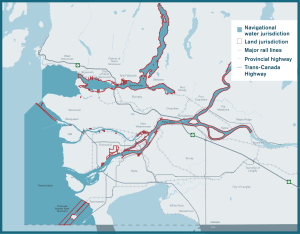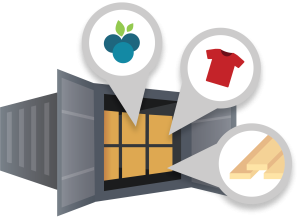The Vancouver Fraser Port Authority: Enabling Canada’s trade
The Vancouver Fraser Port Authority is an arm’s-length federal agency responsible for the shared stewardship of the lands and waters that make up the Port of Vancouver, Canada’s largest port. Our mandate, as outlined in the Canada Marine Act, is to enable Canada’s trade objectives on behalf of all Canadians, ensuring goods are moved safely through the Port of Vancouver, while protecting the environment and considering local communities.
As a Canada Port Authority, we:
- Contribute to the competitiveness, growth, and prosperity of the Canadian economy
- Organize marine transportation services that meet port users’ needs at a reasonable cost
- Provide a high level of safety and environmental protection
- Respond to local needs and priorities
- Encourage and take into account input from port users and local communities
- Re-invest around 90% of our revenues back into trade enabling infrastructure
Our role and responsibilities
In our role, we carry out our mandate by:
- Leasing out lands to the terminal operators who move cargo through the port
- Collecting revenue through tenant rent and various fees from port users
- Leading infrastructure projects to support trade growth
- Serving as a permitting authority for terminal expansions and other projects on port lands
- Running a suite of environmental programs
- Working closely with local communities to minimize any impacts of port activity
- Engaging and creating meaningful relationships with Indigenous groups
- Collaborating with other agencies on port safety and security
What we don’t do
Operations and activities at the port are complex and include many organizations beyond the port authority. There are several activities that we’re not responsible for. For example, we do not:
- Determine what gets traded through the port
- Contribute to decisions about trade policy
- Inspect cargo that moves through the port
- Manage, own, or operate port terminals or ocean-going ships
- Charge fees for demurrage, storage, or detention for containers
- Lead emergency or spill response efforts
- Engage in labour negotiations (except on behalf of port authority employees)
Unlike many other ports around the world, Canada Port Authorities are not tax-payer funded. We also aren’t owned or operated by any municipality.
The Port of Vancouver: Canada’s largest port
 Located on the southwest coast of British Columbia, the port extends from Roberts Bank and the Fraser River up to and including Burrard Inlet. Geographically, the port is about the same size as the next five largest Canadian ports combined. Its jurisdiction includes more than 16,000 hectares of water, more than 1,500 hectares of land and hundreds of kilometres of shoreline, bordering 16 municipalities and intersecting the traditional territories and treaty lands of 35 Coast Salish Indigenous groups.
Located on the southwest coast of British Columbia, the port extends from Roberts Bank and the Fraser River up to and including Burrard Inlet. Geographically, the port is about the same size as the next five largest Canadian ports combined. Its jurisdiction includes more than 16,000 hectares of water, more than 1,500 hectares of land and hundreds of kilometres of shoreline, bordering 16 municipalities and intersecting the traditional territories and treaty lands of 35 Coast Salish Indigenous groups.
Trade at the Port of Vancouver
Trade through the port connects Canadian businesses to international markets and consumers with the variety of products that we use every day from markets across the globe and generates tax revenues and secure employment for local communities. Home to 29 major terminals and more than 1,000 tenants, the port is the most diversified cargo-handling port in North America.
Port terminals move goods across five different business sectors:
 |
 |
 |
 |
 |
| Bulk | Containers | Breakbulk | Automobiles | Cruise |
The Port of Vancouver:
- Connects Canada with approximately 140 to 170 countries annually
- Handles $1 of every $3 of Canada’s trade in goods outside of North America
- Enables the trade of approximately $305 billion in goods annually
- Sustains 115,300 jobs, $7 billion in wages through port activities each year
- Generates $11.9 billion in annual GDP across Canada
